牛津译林版(2019)必修第三册Unit 3 The world online Grammar and usage 课件(共18张PPT)
文档属性
| 名称 | 牛津译林版(2019)必修第三册Unit 3 The world online Grammar and usage 课件(共18张PPT) |  | |
| 格式 | pptx | ||
| 文件大小 | 64.6KB | ||
| 资源类型 | 教案 | ||
| 版本资源 | 牛津译林版(2019) | ||
| 科目 | 英语 | ||
| 更新时间 | 2024-04-02 22:21:42 | ||
图片预览

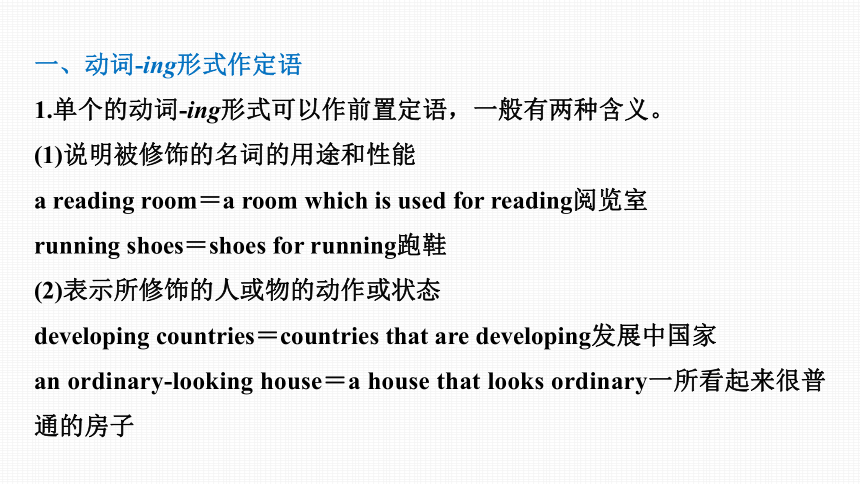
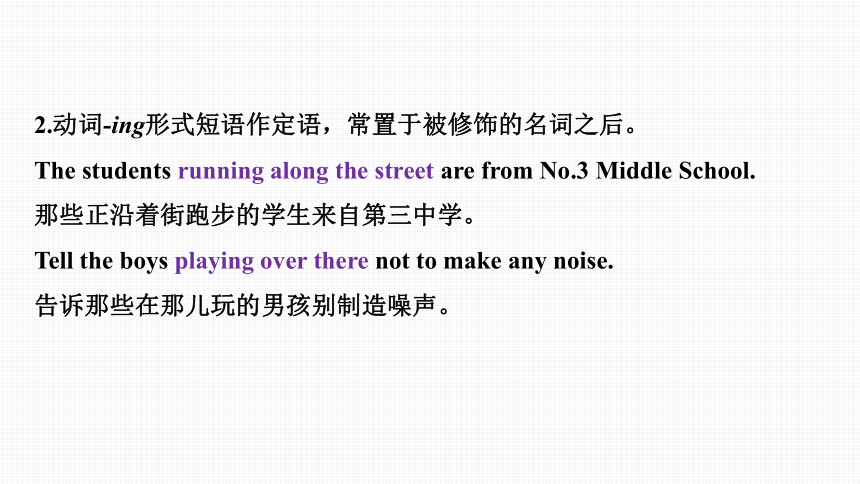
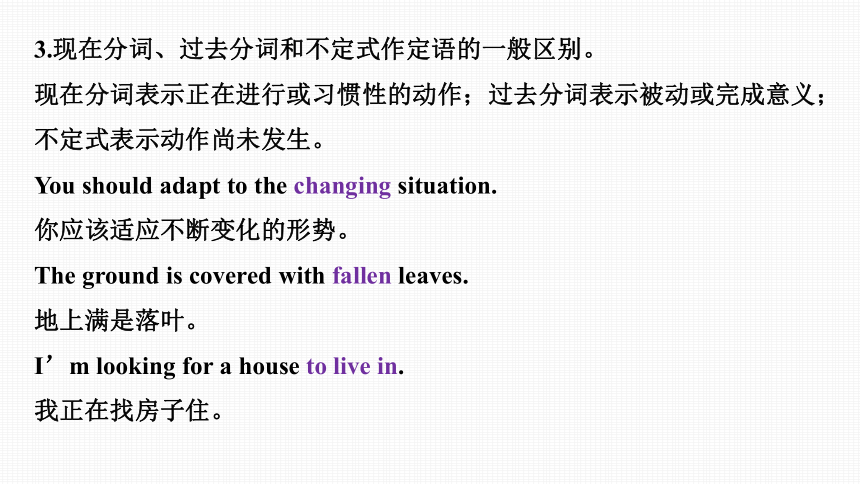
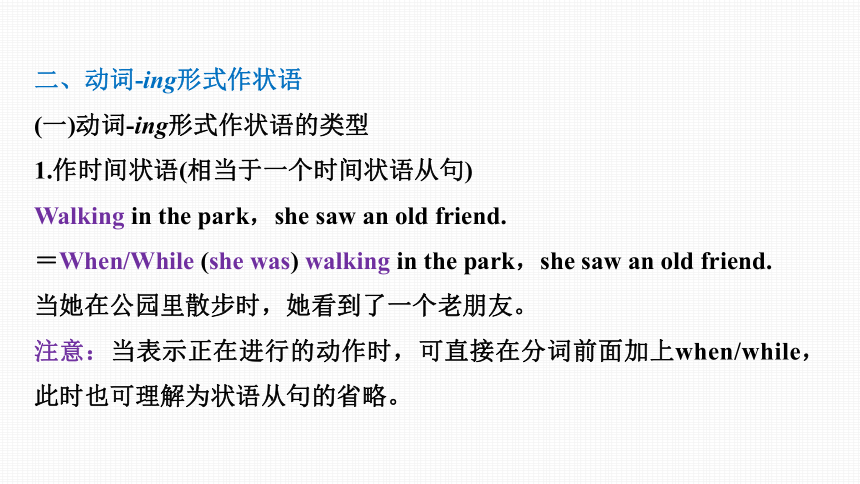
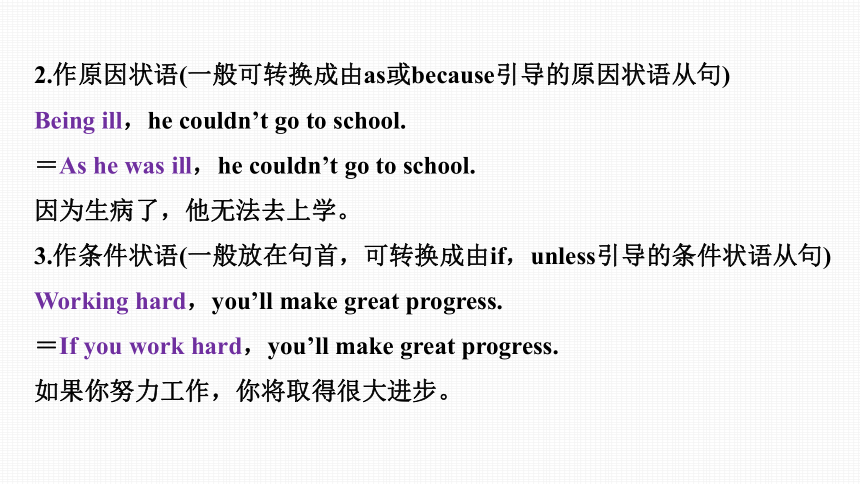

文档简介
(共18张PPT)
Grammar and usage
Unit 3
The world online
一、动词-ing形式作定语
1.单个的动词-ing形式可以作前置定语,一般有两种含义。
(1)说明被修饰的名词的用途和性能
a reading room=a room which is used for reading阅览室
running shoes=shoes for running跑鞋
(2)表示所修饰的人或物的动作或状态
developing countries=countries that are developing发展中国家
an ordinary-looking house=a house that looks ordinary一所看起来很普通的房子
2.动词-ing形式短语作定语,常置于被修饰的名词之后。
The students running along the street are from No.3 Middle School.
那些正沿着街跑步的学生来自第三中学。
Tell the boys playing over there not to make any noise.
告诉那些在那儿玩的男孩别制造噪声。
3.现在分词、过去分词和不定式作定语的一般区别。
现在分词表示正在进行或习惯性的动作;过去分词表示被动或完成意义;不定式表示动作尚未发生。
You should adapt to the changing situation.
你应该适应不断变化的形势。
The ground is covered with fallen leaves.
地上满是落叶。
I’m looking for a house to live in.
我正在找房子住。
二、动词-ing形式作状语
(一)动词-ing形式作状语的类型
1.作时间状语(相当于一个时间状语从句)
Walking in the park,she saw an old friend.
=When/While (she was) walking in the park,she saw an old friend.
当她在公园里散步时,她看到了一个老朋友。
注意:当表示正在进行的动作时,可直接在分词前面加上when/while,此时也可理解为状语从句的省略。
2.作原因状语(一般可转换成由as或because引导的原因状语从句)
Being ill,he couldn’t go to school.
=As he was ill,he couldn’t go to school.
因为生病了,他无法去上学。
3.作条件状语(一般放在句首,可转换成由if,unless引导的条件状语从句)
Working hard,you’ll make great progress.
=If you work hard,you’ll make great progress.
如果你努力工作,你将取得很大进步。
4.作结果状语
动词-ing形式作结果状语时,通常放在句末,中间用逗号隔开,表示一种顺其自然、意料之中的结果。
The hospital has recently obtained new medical equipment,allowing more patients to be treated.
这家医院最近得到一批新的医疗设备,这使更多的病人能得到治疗。
注意:动词-ing形式作结果状语,是随着谓语动作的发生而产生的自然结果,有时前面可加上副词thus,其逻辑主语往往是前面整个句子所描述的情况。而不定式作结果状语时常表示出乎意料的结果,有时前面可以加only。试比较:
He was caught in the rain,thus making himself catch a cold.
被雨淋后他感冒了。
I hurried to school,only to find it was Sunday.
我匆忙赶到学校,结果发现是星期天。
5.作让步、方式和伴随状语
动词-ing形式作让步、方式和伴随状语时,说明动作发生的背景和情况。作伴随状语时,表示分词的动作和谓语动词的动作同时发生,此时相当于一个并列句。
Mary sat by the window of the classroom,reading a book.
=Mary sat by the window of the classroom and she was reading a book.
玛丽坐在教室的窗边读着一本书。
注意:为强调动词-ing形式表达的意义,可在其前加上各种连词。例如,加上when,while,强调与谓语动词的动作同时发生;加上before,after,强调动作先后发生;加上(al)though,强调让步等。
Though knowing all this,they made me pay for the damage.
尽管他们了解这一切,但还是让我赔偿损失。
(二)动词-ing形式作状语的几个难点
1.现在分词的完成式(having done)作状语
当现在分词的动作先发生,而谓语动词的动作后发生时,用现在分词的完成式,并且完成式只能作状语。
Having finished the letter,he went to post it.
他写完信后就把它寄了出去。(finish是先发生的动作,go是后发生的动作)
Having worked for three hours,he took a rest.(work的动作发生在take a rest 的动作之前)
工作了三个小时之后,他休息了一会。
注意:当现在分词和句子主语之间是被动关系时要用被动形式。
Having been shown around the factory,they were very happy.
被领着参观了工厂后,他们很高兴。
2.动词-ing形式的否定式:not+v.-ing;not having+v.-ed
Not knowing this,he didn’t come.
他不知道这件事,所以没来。
Not having made full preparations,we put off the sports meeting.
因为没有做好充分的准备,我们把运动会延期了。
三、动词-ing形式作宾语补足语
动词-ing形式作宾语补足语时,表示正在进行的动作或经常存在的状态。动词-ing形式常在以下结构中作动词的宾语补足语
1.表示感觉和心理状态的感官动词(see,hear,feel,smell,find,notice,observe,look at,listen to等)+sb+doing sth(作宾语补足语)
I felt somebody standing behind me.
我感觉有人站在我后面。
I saw the little boy crying there.
我看到小男孩在那儿哭。
2.表示指使意义的使役动词(have,keep,get,leave等)+sb/sth+doing sth(作宾语补足语)
We kept the fire burning all night long.
我们让火整夜燃烧着。
I won’t have you running about in the room.
我不允许你在房间里跑来跑去。
注意:使役动词接现在分词作宾语补足语表示“让……一直做某事”;接不带to的不定式作宾语补足语表示“让某人做某事”。
The boss made his workers work 12 hours a day.
老板让他的工人们每天工作12 个小时。
3.用于with复合结构中
I couldn’t do my homework with the noise going on.
由于噪音不断,我没法做家庭作业。
With so many people looking at her,she felt nervous.
这么多人看着她,她感到紧张。
返 回
达标检测
用本单元的语法完成下面短文
1. (住得离学校远。现在分词作原因状语),Tom has to take a bus to school every day.One day,he found that the man 2. (站在他旁边的。现在分词作定语) was stealing a wallet from a young lady.Tom told it to the bus driver in a whisper.As soon as the bus arrived at the next stop,he found two policemen 3.________
_____________(正等着这名小偷。现在分词作宾语补足语).
Living far from school
standing next to him
for the thief
waiting
Grammar and usage
Unit 3
The world online
一、动词-ing形式作定语
1.单个的动词-ing形式可以作前置定语,一般有两种含义。
(1)说明被修饰的名词的用途和性能
a reading room=a room which is used for reading阅览室
running shoes=shoes for running跑鞋
(2)表示所修饰的人或物的动作或状态
developing countries=countries that are developing发展中国家
an ordinary-looking house=a house that looks ordinary一所看起来很普通的房子
2.动词-ing形式短语作定语,常置于被修饰的名词之后。
The students running along the street are from No.3 Middle School.
那些正沿着街跑步的学生来自第三中学。
Tell the boys playing over there not to make any noise.
告诉那些在那儿玩的男孩别制造噪声。
3.现在分词、过去分词和不定式作定语的一般区别。
现在分词表示正在进行或习惯性的动作;过去分词表示被动或完成意义;不定式表示动作尚未发生。
You should adapt to the changing situation.
你应该适应不断变化的形势。
The ground is covered with fallen leaves.
地上满是落叶。
I’m looking for a house to live in.
我正在找房子住。
二、动词-ing形式作状语
(一)动词-ing形式作状语的类型
1.作时间状语(相当于一个时间状语从句)
Walking in the park,she saw an old friend.
=When/While (she was) walking in the park,she saw an old friend.
当她在公园里散步时,她看到了一个老朋友。
注意:当表示正在进行的动作时,可直接在分词前面加上when/while,此时也可理解为状语从句的省略。
2.作原因状语(一般可转换成由as或because引导的原因状语从句)
Being ill,he couldn’t go to school.
=As he was ill,he couldn’t go to school.
因为生病了,他无法去上学。
3.作条件状语(一般放在句首,可转换成由if,unless引导的条件状语从句)
Working hard,you’ll make great progress.
=If you work hard,you’ll make great progress.
如果你努力工作,你将取得很大进步。
4.作结果状语
动词-ing形式作结果状语时,通常放在句末,中间用逗号隔开,表示一种顺其自然、意料之中的结果。
The hospital has recently obtained new medical equipment,allowing more patients to be treated.
这家医院最近得到一批新的医疗设备,这使更多的病人能得到治疗。
注意:动词-ing形式作结果状语,是随着谓语动作的发生而产生的自然结果,有时前面可加上副词thus,其逻辑主语往往是前面整个句子所描述的情况。而不定式作结果状语时常表示出乎意料的结果,有时前面可以加only。试比较:
He was caught in the rain,thus making himself catch a cold.
被雨淋后他感冒了。
I hurried to school,only to find it was Sunday.
我匆忙赶到学校,结果发现是星期天。
5.作让步、方式和伴随状语
动词-ing形式作让步、方式和伴随状语时,说明动作发生的背景和情况。作伴随状语时,表示分词的动作和谓语动词的动作同时发生,此时相当于一个并列句。
Mary sat by the window of the classroom,reading a book.
=Mary sat by the window of the classroom and she was reading a book.
玛丽坐在教室的窗边读着一本书。
注意:为强调动词-ing形式表达的意义,可在其前加上各种连词。例如,加上when,while,强调与谓语动词的动作同时发生;加上before,after,强调动作先后发生;加上(al)though,强调让步等。
Though knowing all this,they made me pay for the damage.
尽管他们了解这一切,但还是让我赔偿损失。
(二)动词-ing形式作状语的几个难点
1.现在分词的完成式(having done)作状语
当现在分词的动作先发生,而谓语动词的动作后发生时,用现在分词的完成式,并且完成式只能作状语。
Having finished the letter,he went to post it.
他写完信后就把它寄了出去。(finish是先发生的动作,go是后发生的动作)
Having worked for three hours,he took a rest.(work的动作发生在take a rest 的动作之前)
工作了三个小时之后,他休息了一会。
注意:当现在分词和句子主语之间是被动关系时要用被动形式。
Having been shown around the factory,they were very happy.
被领着参观了工厂后,他们很高兴。
2.动词-ing形式的否定式:not+v.-ing;not having+v.-ed
Not knowing this,he didn’t come.
他不知道这件事,所以没来。
Not having made full preparations,we put off the sports meeting.
因为没有做好充分的准备,我们把运动会延期了。
三、动词-ing形式作宾语补足语
动词-ing形式作宾语补足语时,表示正在进行的动作或经常存在的状态。动词-ing形式常在以下结构中作动词的宾语补足语
1.表示感觉和心理状态的感官动词(see,hear,feel,smell,find,notice,observe,look at,listen to等)+sb+doing sth(作宾语补足语)
I felt somebody standing behind me.
我感觉有人站在我后面。
I saw the little boy crying there.
我看到小男孩在那儿哭。
2.表示指使意义的使役动词(have,keep,get,leave等)+sb/sth+doing sth(作宾语补足语)
We kept the fire burning all night long.
我们让火整夜燃烧着。
I won’t have you running about in the room.
我不允许你在房间里跑来跑去。
注意:使役动词接现在分词作宾语补足语表示“让……一直做某事”;接不带to的不定式作宾语补足语表示“让某人做某事”。
The boss made his workers work 12 hours a day.
老板让他的工人们每天工作12 个小时。
3.用于with复合结构中
I couldn’t do my homework with the noise going on.
由于噪音不断,我没法做家庭作业。
With so many people looking at her,she felt nervous.
这么多人看着她,她感到紧张。
返 回
达标检测
用本单元的语法完成下面短文
1. (住得离学校远。现在分词作原因状语),Tom has to take a bus to school every day.One day,he found that the man 2. (站在他旁边的。现在分词作定语) was stealing a wallet from a young lady.Tom told it to the bus driver in a whisper.As soon as the bus arrived at the next stop,he found two policemen 3.________
_____________(正等着这名小偷。现在分词作宾语补足语).
Living far from school
standing next to him
for the thief
waiting
同课章节目录
- Unit 1 Nature in the balance
- Welcome to the unit
- Reading
- Grammar and usage
- Integrated skills
- Extended reading
- Project
- Unit 2 Natural disasters
- Welcome to the unit
- Reading
- Grammar and usage
- Integrated skills
- Extended reading
- Project
- Unit 3 The world online
- Welcome to the unit
- Reading
- Grammar and usage
- Integrated skills
- Extended reading
- Project
- Unit 4 Scientists who changed the world
- Welcome to the unit
- Reading
- Grammar and usage
- Integrated skills
- Extended reading
- Project
